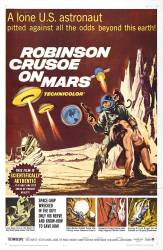Continuity mistake: While avoiding the glowing meteoroid, they decide to fire their jets to push them into a higher orbit. In a couple of scenes they go up but a third one has them going back down.
Continuity mistake: Mantee finds a pool of water after falling through a hole. He gets in nude, but you can see him wearing tan-colored trunks during the close-ups. However, the far away shots do show him naked.
Revealing mistake: The ground beneath Mantee's feet gives way with him falling through the hole. Boy, that hole sure looked rectangular.
Visible crew/equipment: Paul Mantee's helmet reflects two stage lights often when he is supposedly outside.
Factual error: Draper consults a recorded video-lecture on survival tips while on Mars. Behind the lecturer is a chalkboard with two force laws from physics written. One is Newton's law of gravity, the other is Coulomb's law for electric charges. The constant of proportionality for Coulomb's law is given as e0, whereas this is really only one component in the whole expression for the constant, 1/e04pi.
Revealing mistake: Early in the film, when Commander Chris Draper is still wearing his space gear on the Martian surface, multiple helmet reflections reveal that at least two and as many as four powerful artificial light sources (in addition to the Sun) were used to illuminate the exterior scenes.
Revealing mistake: Several scenes used a fake monkey to protect the live one from injury. The "stunt monkey" is most obvious in the scenes where Draper is climbing the steep cliff walls with the mannequin attached to his rucksack.
Other mistake: The abandoned orbiter requires fuel to decelerate and drop out of its stable orbit. Mantee knew the orbiting spacecraft was out of fuel before leaving it, but he was still trying to give the craft voice commands to land some forty minutes into the film.






Answer: This is pure Hollywood fiction, never meant to be science-based fact, and was typical of sci-fi films of that era such as: War of the Worlds, Invaders From Mars, The Martian Chronicles, and others. Many were based on early-to-mid-20th century science-fiction novels when little was scientifically known about any of the planets. Authors imagined what Mars was like purely to entertain readers. After the 1960s, as more was scientifically known about Mars, films became more realistic, although the 2012 Disney film, "John Carter," was a deliberate throwback to that earlier genre. Also, scientists never believed that there were canals on Mars. In the 1870s, Italian astronomer Giovanni Schiaparelli was mapping Mars through a telescope. He described the long, trench-like geographical features as "canali," (Italian for channels). American astronomer Percival Lowell misinterpreted this as "canals" and believed they were of intelligent origin, though other scientists debunked that. Sci-fi writers of the time (H.G. Wells, Edgar Rice Boroughs, et al) incorporated Lowell's published theories into their stories.
raywest ★
It should be noted "John Carter" is based on the 1912 novel "A Princess of Mars."
Bishop73